Text
History with Conan: Japan’s Yayoi Period (Worldwide Contemporaries)

While Japan was in the Yayoi period, the Roman Empire’s power in Europe was expanding. Beginning in the 8th century BCE in a small city on the Italian peninsula, Rome had unified the country by 272 BCE. Then they conquered the surrounding nations and expanded their dominion across the Mediterranean Coast. In 27 BCE, Rome became an empire, ruled by an emperor. By 117 CE, its territory had reached its peak size. Under the strong rule of the Roman emperor, the empire was at peace, and literature, philosophy, and art flourished. When the emperor made Christianity the national religion, Christianity took root in Europe, which had a major effect on Europe’s history and culture.
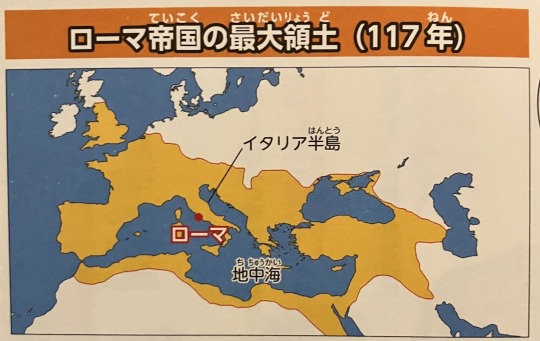
Territory of the Roman Empire in 117 BCE, Rome marked in red.
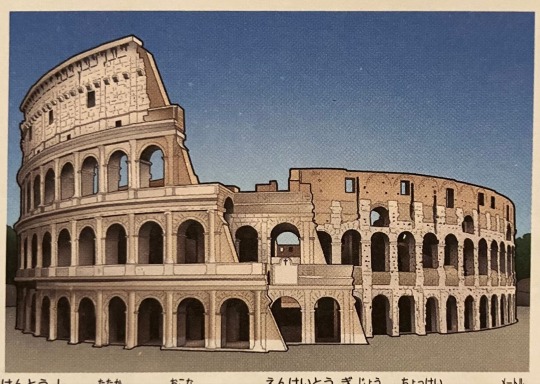

Roman ruins: the Colosseum and the aqueducts. The Colosseum hosted fights within its 50 meter walls (164 feet). With a diameter of 188 meters (616 feet), it’s a giant work of architecture. The aqueducts were built to carry water from rivers and valleys in order to manage the empire’s water supply.
With illustrations and information from History Detective Conan 2: Yayoi Period (The Lonely Little Queen).
That’s all for the Yayoi period! Coming soon: Japan’s Kofun Period
Kofi Tip Jar
5 notes
·
View notes
Text
History with Conan: Japan’s Yayoi Period (Himiko's Grave?)
Influential people in ancient times were buried in earthen mounds called kofun. There are various types of kofun, but this time we’ll be talking about the Hashihaka Kofun in Sakurai, Nara Prefecture. The Hashihaka Kofun seen from above is shaped like a keyhole, made up of intersecting square and circular shapes. This type of kofun began to be built around the mid-third century. The Hashihaka Kofun is one of the earliest of its kind, and it’s theorized that it may be Himiko’s grave. There are two reasons for this theory: the first is that the diameter of the circular portion of this kofun is believed to match the size of Himiko’s grave as written in the Treatise on the Wa People almost exactly. The second is that it’s believed to have been made around the time Himiko died. Additionally, since there was a large moated settlement nearby at the Makimuku Site, it’s said that that settlement may have even been Yamatai’s capital! Of course, if these theories are right, then the location of Yamatai would be confirmed in the Kinki region…
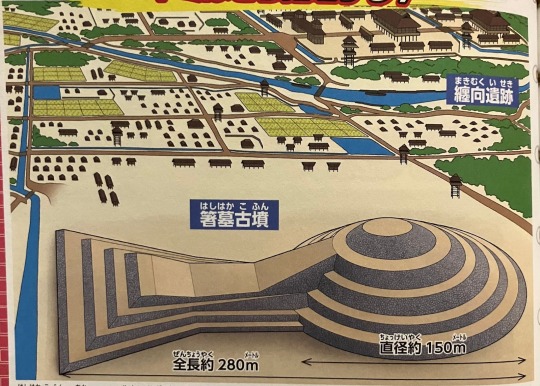
The Hashihaka Kofun, with the Makimuku Site in the background. The kofun is 280 meters long (almost 920 feet) and the circular portion has a diameter of 150 meters (around 492 feet).
Point 1: Made in Himiko’s time? It was once thought that this kofun was made after Himiko’s time, but there’s now research that suggests it could have been made in the era of her death.
Point 2: The size matches? The 150 meter diameter of the circular portion is close to what’s written in the Treatise on the Wa People, but the Treatise doesn’t specify that Himiko’s grave was a kofun of this type.
With illustrations and information from History Detective Conan 2: Yayoi Period (The Lonely Little Queen).
Next Time: Worldwide Contemporaries
Kofi Tip Jar
2 notes
·
View notes
Text
History with Conan: Japan’s Yayoi Period (Where Was Yamatai?)
The Treatise on the Wa People describes a route to Yamatai from the Korean peninsula, but if you followed that route, you’d end up in the sea to the south of Kyushu. The actual location of Yamatai has been the subject of much debate. The top theories locate it in Kyushu or the Kinki region, but no concrete evidence has yet been found.
The route to Yamatai as written in the Treatise on the Wa People:
Note: a ri (or li in Chinese) is a traditional unit of measurement equal to about half a kilometer or a third of a mile, but was not standardized at the time the way our modern units are. Each step is followed by the modern location it corresponds to.
From the Daifang Commandery, travel 7000 ri to the Gaya Confederacy (southern Korean peninsula)
1000 ri to Tsushima (Tsushima, Nagasaki Prefecture)
1000 ri to Iki (Iki, Nagasaki Prefecture)
1000 ri to Matsura (East Matsura District, Saga Prefecture)
500 ri to Ito (Itoshima, Fukuoka Prefecture)
100 ri to Na (Fukuoka, Fukuoka Prefecture)
100 ri to Fumi (???)
Travel 20 days on the water to Touma (???)
Travel by water 10 days, then by land 30 days to Yamatai (???)
Here’s a map of the journey from Daifeng to Yamatai. We can understand much of it based on what we do know, but after that, there are different theories about distance and direction of travel that change where the route ends.

Ayumi: I’m lost, which is right?
Mitsuhiko: If you go straight east from Na, you end up in the Kinki region…
Genta: Kyushu is the closest to Daifeng…
The purple line on the map follows the route from Daifeng to Na. After that point, the two theories are shown. The Kyushu theory (in red, left) shows Fumi and Touma in what’s now Oita Prefecture, and Yamatai in the area of Miyazaki or Kumamoto Prefectures. The Kinki theory (in blue, right) shows Fumi in today’s Yamaguchi Prefecture, Touma in Hiroshima or Okayama Preffectures, and Yamatai in Nara or Wakayama Prefectures.
With illustrations and information from History Detective Conan 2: Yayoi Period (The Lonely Little Queen).
Next Time: Himiko's Grave?
Kofi Tip Jar
1 note
·
View note
Text
History with Conan: Japan’s Yayoi Period (Yayoi Kids)
Plenty of artifacts relating to Jomon period children have been found, but this isn’t the case for Yayoi children. It’s believed that this is because child mortality declined with the spread of rice cultivation creating a more stable lifestyle. We don’t know much about Yayoi kids, but it’s likely they worked in the rice fields with the adults.

Growing rice was a collaborative effort between the people in a village. Even children probably helped with planting and harvesting.
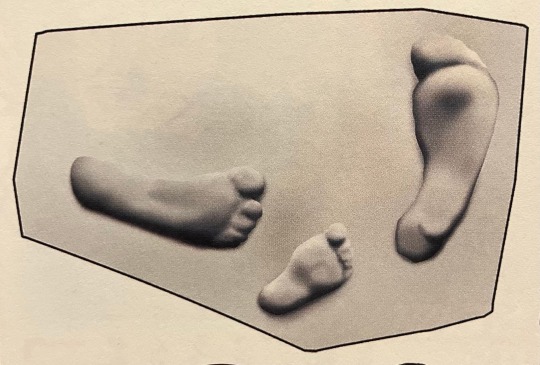
Children’s footprints have been found mixed with adults’ in what was once a flooded rice paddy at the Tareyanagi Site in Aomori Prefecture. They were likely following the adults to help them work.
With illustrations and information from History Detective Conan 2: Yayoi Period (The Lonely Little Queen).
Next Time: Where Was Yamatai?
Kofi Tip Jar
2 notes
·
View notes
Text
History with Conan: Japan’s Yayoi Period (The Yoshinogari Site)
Yoshinogari Historical Park is the site of a Yayoi moated settlement in Yoshinogari, Kanzaki District, Saga Prefecture. It’s the largest Yayoi settlement, at the size of 22 Tokyo Domes (1040000 square meters, 11190000 square feet), with the settlement at the center. The reconstructed buildings include a shrine, a royal residence, watchtowers, raised-floor storehouses, and pillar-supported buildings. Like the Jomon Sannai Maruyama Site, you can visit this to see it for yourself.
Map of the Reconstruction


In the top left, there are many storehouses and a marketplace (indicated in red). Below that is an area for royalty, with a royal residence (to the right) and watchtowers. At the bottom of the map, we can see a watchtower gate guarding the entrance. On the right is the center where festivals and important meetings would have been held. The entrance near the bottom twists to make it hard for large groups to enter quickly in case of an attack. Two sets of walls and moats surround this area, though the moats were empty. There are watchtowers here too. Near the top we have a building used for festivals (rightmost label) and the main shrine.
With illustrations and information from History Detective Conan 2: Yayoi Period (The Lonely Little Queen).
Next Time: Yayoi Kids
Kofi Tip Jar
2 notes
·
View notes
Text
History with Conan: Japan’s Yayoi Period (The Yayoi Diet)
Yayoi people ate many of the same things as Jomon people: animals, fish, shellfish, and nuts. But with the spread of rice cultivation, rice was now on the menu as well. But it wasn’t eaten every day in larger amounts like rice in modern Japan. Rice was still valuable enough that it was often mixed into things like porridge, made with what are called the five grains: wheat, rice, beans, and two types of millet (awa and hie). This information comes from the Nihon Shoki, a Japanese history book from 720 CE. Grains like rice are very nutritious and can be grown in large amounts in a small area, so the Yayoi people could support a higher population across Japan than the Jomon people, who relied on the whims of nature.

The five grains, clockwise from top right: awa, beans, hie, wheat. Center: rice.

A Yayoi feast!
Top row, left to right: sake, rice porridge, shellfish soup, fruits
Middle/bottom row: vegetables, acorn dango, fish, meat, nuts

Ayumi: They didn’t have chopsticks yet, so they ate with their hands or with wooden spoons!
With illustrations and information from History Detective Conan 2: Yayoi Period (The Lonely Little Queen).
Next Time: The Yoshinogari Site
Kofi Tip Jar
3 notes
·
View notes
Text
History with Conan: Japan’s Yayoi Period (Yayoi Fashion)

Yayoi people wore simple sloths made from a single piece of cloth woven from hemp with a hole for the neck, regardless of gender. Underneath, it’s thought that men wore a loincloth called a fundoshi, and women wore a skirt-like garment wrapped around the waist called a koshinuno. This was much like Jomon fashion, but this time we’ll see how you’d put on the outer layer.
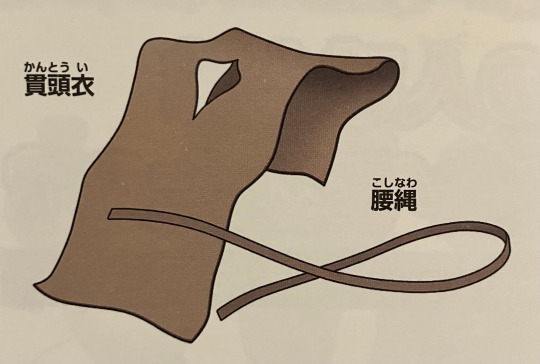
Step 1: Put on the koshinuno (or fundoshi), and put the outer garment over your head
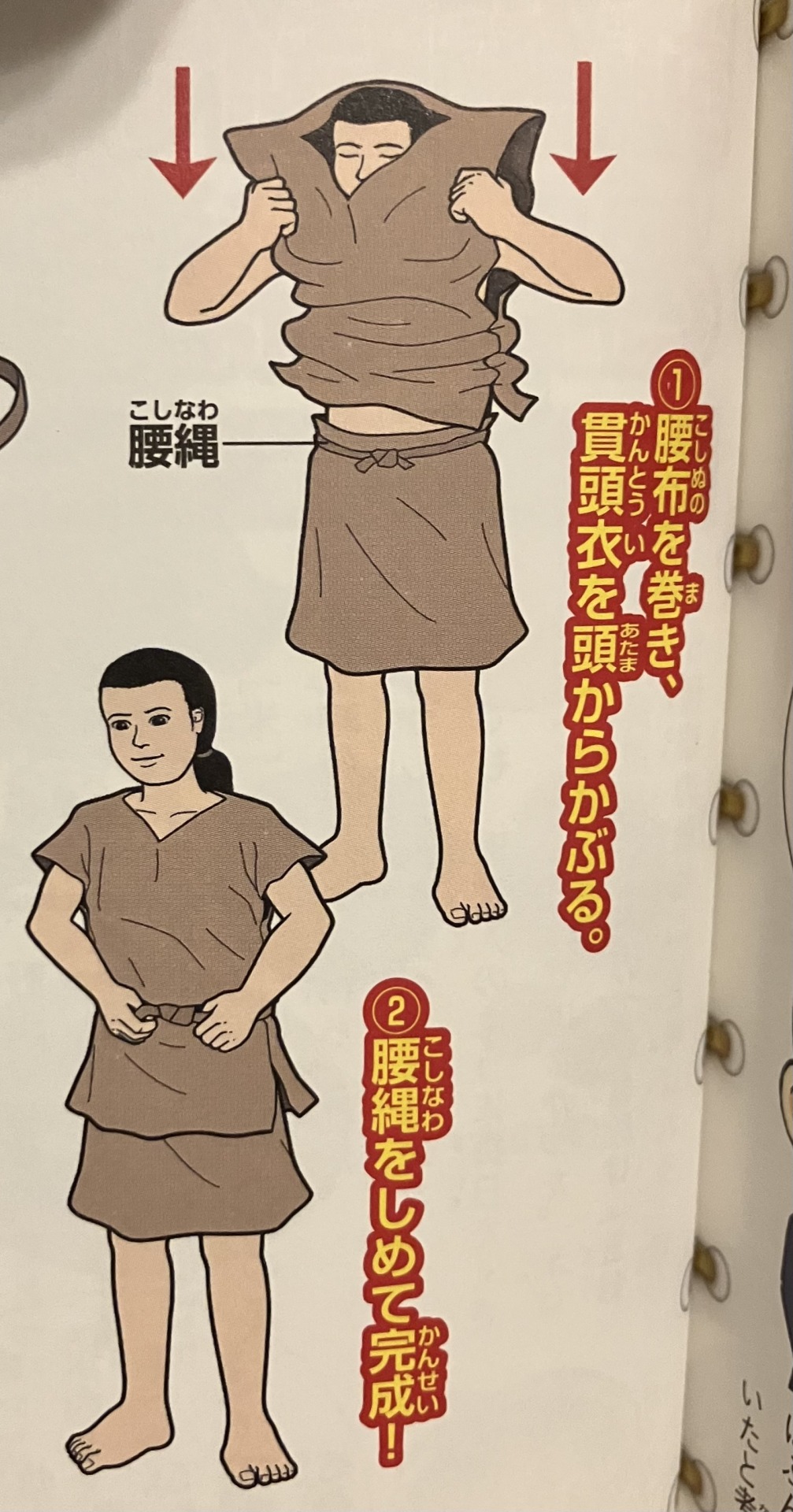
Step 2: Tie the waist cord, and you’re done!

Woman: Don’t forget the accessories!
People wouldn’t start wearing the kimono we think of as quintessential Japanese fashion until much later.
With illustrations and information from History Detective Conan 2: Yayoi Period (The Lonely Little Queen).
Next Time: The Yayoi Diet
Kofi Tip Jar
3 notes
·
View notes
Text
History with Conan: Japan’s Yayoi Period (Pottery: Jomon vs Yayoi)
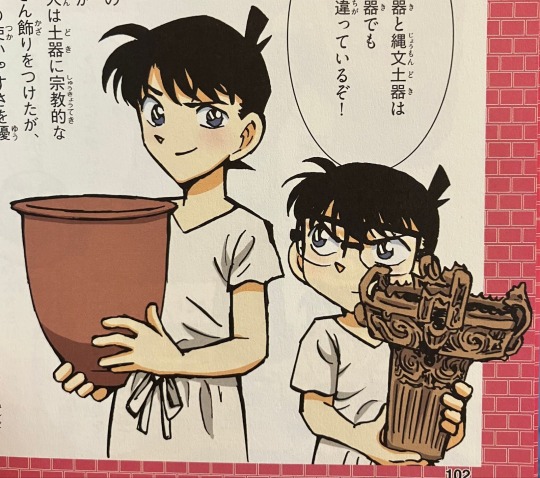
How did Yayoi pottery differ from Jomon pottery? You can see a major difference at first glance: Yayoi pottery doesn’t have the ornamentation of Jomon pottery. Jomon pottery was ornate because it had religious meaning, but Yayoi pottery was used more practically, so it’s thought they preferred simplicity for ease of use. The differences aren’t all visible, though: Yayoi pottery is stronger and thinner than Jomon because of the differences in the way each type was made. The hotter the temperature at which the clay is fired, the stronger the pottery, making it harder to break and allowing it to be made thinner.

Jomon firing: The pot sits on kindling, surrounded by more kindling and dry leaves.. The heat could escape, so the temperature didn’t get high. This means the pottery wouldn’t be very strong, so it was made thicker to compensate.
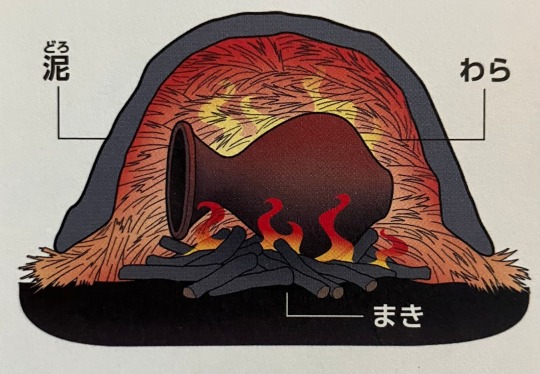
The pot sits on kindling, surrounded by straw and then covered in earth. The earthen layer prevents the heat from escaping, allowing pottery to be fired at high temperatures and thus made thinner and stronger.
With illustrations and information from History Detective Conan 2: Yayoi Period (The Lonely Little Queen).
Next Time: Yayoi Fashion
Kofi Tip Jar
9 notes
·
View notes
Text
History with Conan: Japan’s Yayoi Period (Bronzeware)
Bronzeware was the latest in Yayoi technology. Bronze is made from copper and tin, and began to be produced around 2000 BCE.The Yayoi people made things like weapons and mirrors from bronze, as well as bell shaped vessels that are unique to Japan. These were first made at ordinary bell size and grew bigger as they were used for ceremonial purposes, until they were making giant bells even taller than a child. When you see them in museums today, they’re green with patina, but when they were new, these objects would have been bronze colored and shiny.

Bell: 134.7 cm (around 4.4 ft). Conan: 102 cm (around 3.3 ft).
Japan’s biggest bronze bell (found in Shiga Prefecture): This giant bell weighs 45.5 kg (around 100 lbs). It was discovered in Sanchu, Yasu City, Shiga Prefecture, and is now displayed in the Tokyo National Museum as an Important Cultural Property of Japan.
How a bell is made:

Two halves of the outer mold are made from clay, with the design carved into the inside.
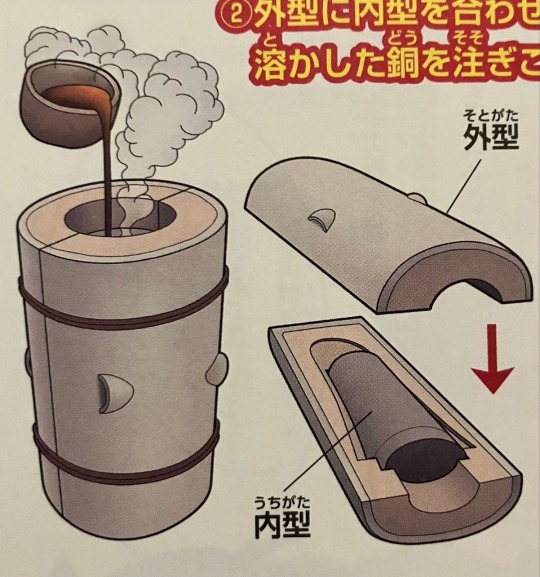
The inner mold is lined up with the outer mold, and molten bronze is poured in.

When the bronze has hardened, the mold is broken apart to remove the bell
Agasa: Remove the extra bits, polish it up, and it’s done!

Conan: The tongue is suspended inside to make the bell ring when it strikes the body!
With illustrations and information from History Detective Conan 2: Yayoi Period (The Lonely Little Queen).
Next Time: Pottery: Jomon vs Yayoi
Kofi Tip Jar
3 notes
·
View notes
Text
History with Conan: Japan’s Yayoi Period (An Age of War)

When rice cultivation became widespread, people’s way of life became easier. And yet, war was a hallmark of the Yayoi period. Rice cultivation required a lot of people, so they came together in villages. Soon, with different prosperity in harvests, some villages became wealthy and others poor. From there, a scramble for rice and rice growing land began. The evidence of war is found in settlements with moats and fences, lots of bronze weapons, and bones with evidence of war wounds. As villages were unified in war, countries were born.

A moated settlement features a deep moat, surrounding fence, and a lookout tower standing guard over the area.
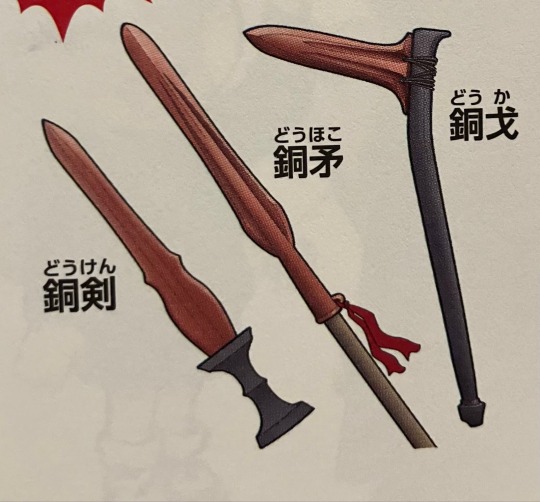
Bronze weapons, from left to right: sword, spearhead, and dagger-axe

Bones with evidence of war: this skeleton has no head!
With illustrations and information from History Detective Conan 2: Yayoi Period (The Lonely Little Queen).
Next Time: Bronzeware
Kofi Tip Jar
6 notes
·
View notes
Text
History with Conan: Japan’s Yayoi Period (Himiko's Hundred Bronze Mirrors)
In the Treatise on the Wa People, it says that Himiko received one hundred bronze mirrors from the emperor of Cao Wei. Bronze mirrors were used in Japan at this time for ceremonial purposes, including spells and fortune telling. They were holy objects rather than a way to see your reflection like modern mirrors. Various types of bronze mirrors have been found from the Yayoi period and the Kofun period after it, but are Himiko’s among them? The research to answer that question is still ongoing.
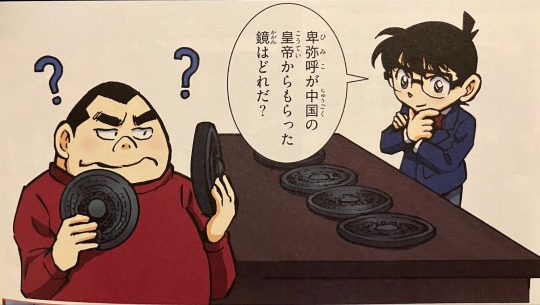
Both of the following mirrors depict divine beasts such as dragons, but each is a different style.

Picture-rimmed mirror: This type has a design around the rim. It was made in Himiko’s time, and this style has also been found in China, leading some to believe that this was the type of mirror Himiko received.

Triangular-rimmed mirror: The rim has a triangular cross section on this style of mirror. For many years, this was strongly believed to be the type of mirror Himiko had, but doubts have arisen, such as the style being made after Himiko’s time, or these mirrors having only been found in Japan, leading to the theory that they were made there.
With illustrations and information from History Detective Conan 2: Yayoi Period (The Lonely Little Queen).
Next Time: An Age of War
Kofi Tip Jar
6 notes
·
View notes
Text
History with Conan: Japan’s Yayoi Period (Yamatai)
Around the end of the Yayoi period, in the 3rd century, one of Japan’s countries was Yamatai. This name first appears in the Chinese history book Records of the Three Kingdoms, in the Treatise on the Wa People. According to this treatise, Wa was made up of more than 30 countries at this time. Yamatai united them under a queen named Himiko. The treatise also tells us about the lives of the Wa people: things like “The Wa people’s specialty is diving into the sea to catch fish” and “They eat raw vegetables in any season”. This gives us valuable information on how Japan came to be. However, there are also plenty of things that we don’t yet understand.

3 facts about Yamatai as written in the Treatise on the Wa People:
It used to be ruled by a king: before Himiko became queen, a man was king of Wa. But due to the endless fighting across the country, the people came together and made Himiko, who had strong spiritual powers, the queen, and the fighting abated.
Himiko remained unmarried through her whole life: Himiko lived in a grand palace, and even had 1000 servants, but she didn’t appear in public often. She never married, and her younger brother helped her with governance.
She sent envoys to China: in the year 239, Himiko sent an envoy to the emperor of Cao Wei and was recognized with the title Ruler of Wa, Friend to Wei. She received a golden seal like the ruler of Na, but it hasn’t been found.

Conan: The country of Kuna, to the south of Yamatai, was ruled by a man. Yamatai and Kuna had a poor relationship, and went to war!
“Wait, I’m confused! I thought Japan was Wa?” Let’s review: Wa is what’s now the country of Japan as a whole. Within Wa, there were different countries at different times. Yamatai was one of them, made from the unification of multiple countries.
With illustrations and information from History Detective Conan 2: Yayoi Period (The Lonely Little Queen). Once again, I used wikipedia for help with spelling Chinese names such as Cao Wei.
Next Time: Himiko's Hundred Bronze Mirrors
Kofi Tip Jar
1 note
·
View note
Text
History with Conan: Japan’s Yayoi Period (Wa: Japan as Written in Chinese History)

Yayoi period Japan didn’t have written language yet, but that doesn’t mean there are no written records of it during this time. Japan, then called “Wa”, sent messengers to China’s Western Han Dynasty and Eastern Han Dynasty. Thus, we have written record of Wa in Chinese history.
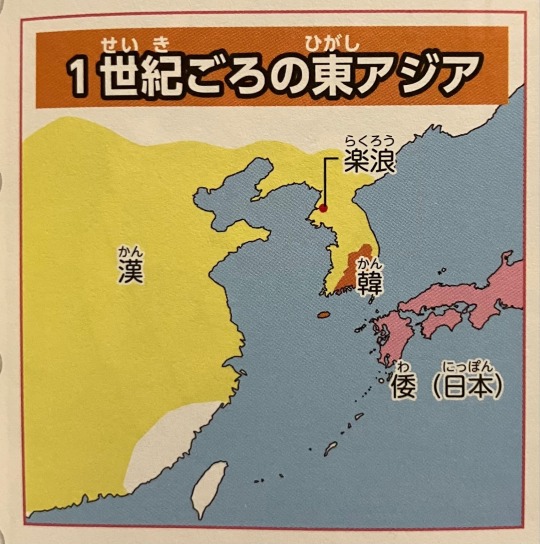
Map of East Asia around the 1st century CE. Pink is Wa (Japan), red is Kan (Korea), above that is Lelang, indicated by the red dot. Yellow is Han (China).
The Book of Han: Treatise of Geography
This Western Han Dynasty history book says “The Wa people live on the sea beyond Lelang [an area which is now part of North Korea]. They are split into more than 100 countries, and send envoys periodically.”
The Book of the Later Han: Treatise on the Dongyi [a collective term for eastern China and further east, Korea and Japan]
This Eastern Han Dynasty history book says “In the year 57 of the current era, the ruler of the country of Na in Wa sent an envoy, and the emperor sent them a gold seal.”

This is a gold seal discovered on the island of Shikano in Fukuoka Prefecture, thought to be the one received by the ruler of Na.It’s engraved “ruler of Na, of Wa, of Kan” or, in Chinese, Han. This was the Han emperor recognizing the ruler of Na. The emperor gave gold seals to surround countries, which showed that their rulers were connected to him and showed their power.
With illustrations and information from History Detective Conan 2: Yayoi Period (The Lonely Little Queen). I was not able to find translations of the Book of Han and the Book of the Later Han passages in English, so the translations here are my own. That means they’re translated from the “easier for kids” language of the Japanese translation in the Conan book rather than directly from the original Chinese. I used Wikipedia for help with the Chinese spellings of place names like Lelang. Note also that I’m not familiar with Chinese history, so if I’ve used the wrong terms or spellings, please let me know.
Next Time: Yamatai
Kofi Tip Jar
8 notes
·
View notes
Text
History with Conan: Japan’s Yayoi Period (Rice Cultivation)

Around the 4th century BCE, people migrating from China and the Korean peninsula brought rice cultivation to northern Kyushu. From there, it spread across Japan. The hunter gatherer lifestyle relied on the whims of nature, but now people could grow food with their own efforts.Food security led to a more stable lifestyle.

Middle: Yangtze. Clockwise from top right: Korean Peninsula, Taiwan, Southeast Asia, Yunnan Province.
Detective Boys: Wooow!
Rice cultivation began by tending to wild rice around 7000 years ago along China’s Yangtze River. From there it spread to places like China’s Yunnan Province, Southeast Asia, Taiwan, the Korean Peninsula, and Japan.
With illustrations and information from History Detective Conan 2: Yayoi Period (The Lonely Little Queen)
Next Time: Wa: Japan as Written in Chinese History
Kofi Tip Jar
5 notes
·
View notes
Text
History with Conan: Japan’s Yayoi Period (Introduction: Jomon to Yayoi)
The Yayoi period was a period of about 700 years, from around the 4th century BCE to around the 3rd century CE. The big development in this period was the introduction of rice cultivation from the continent, and its spread across Japan.This changed daily life quite a bit.

Yayoi people also began making different pottery than the Jomon rope-patterned vessels, but just like the Jomon period, the era is named for its pottery (kind of). Yayoi period pottery was discovered in what’s now Tokyo’s Bunkyo Ward, in a neighborhood called Yayoi. Thus, the pottery was called Yayoi pottery, and the era they were made came to be called the Yayoi period.

Right: hunter gatherer. Left: the beginning of rice cultivation.
The last big change is that rather than stone and bone, people began using iron and bronze. We’ve now entered the Bronze Age, leaving behind the Stone Age of the Jomon period.
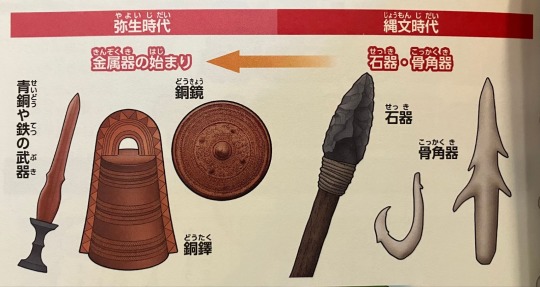
Right: stone and bone tools. Left: metal weapon, bell, and mirror.
With illustrations and information from History Detective Conan 2: Yayoi Period (The Lonely Little Queen)
Next Time: Rice Cultivation
Kofi Tip Jar
9 notes
·
View notes
Text
History with Conan: Japan’s Jomon Period (Worldwide Contemporaries)
While Japan was in the Jomon period, what was going on in the rest of the world?

Egypt’s Tutankhamun lived during the late Jomon period! Other ancient cultures were flourishing during this period too, like Mesopotamia, the Indus Valley Civilization, and ancient China.
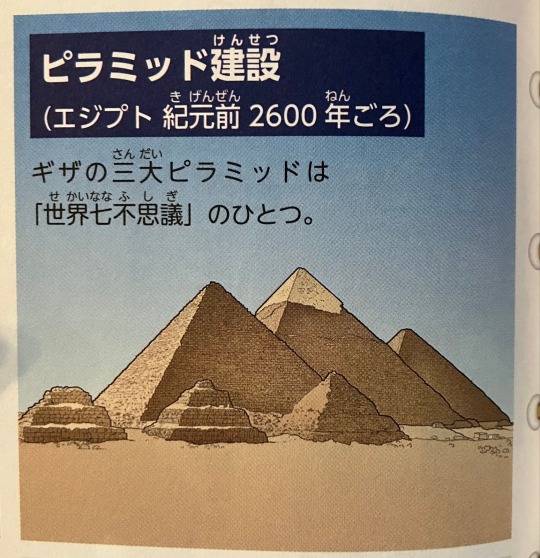
Construction of the pyramids (Egypt, around 2600 BCE)

The Olympics begin (Greece, 776 BCE). The roots of today’s Olympics.

Stonehenge built (England, around 2500 BCE)

Oracle bone script is born (China, around 1300 BCE). These characters were the foundation of modern kanji.
With illustrations and information from History Detective Conan 1: Jomon Period (Time Drifters in a Primitive World).
That’s all for the Jomon period! Coming soon: Japan’s Yayoi Period.
Kofi Tip Jar
2 notes
·
View notes
Text
History with Conan: Japan’s Jomon Period (Before Jomon: The Paleolithic Period)
What was life like before the Jomon period, in the Paleolithic period? Paleolithic people began using chipped stone tools. Like the Jomon people, they were hunter-gatherers. But unlike the Jomon people, they were nomadic, following the large animals they hunted. When the ice age ended and the climate warmed, the large animals went extinct, and the people began raising plants. This is when the nomadic lifestyle ended, and fixed settlements began.

Hunting: A group would chase a large animal like a Naumann’s elephant (Palaeoloxodon naumanni) into a pit trap.
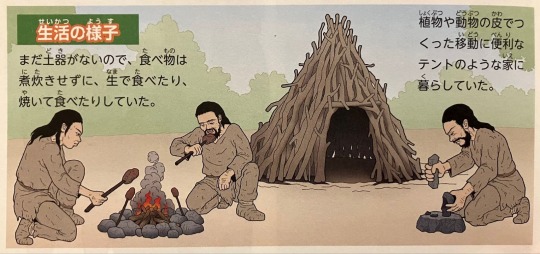
Daily life: Without earthenware for cooking, food was eaten raw or roasted. They lived in easy to move tents made from plants or animal hides.
With illustrations and information from History Detective Conan 1: Jomon Period (Time Drifters in a Primitive World).
Next Time: Worldwide Contemporaries
Kofi Tip Jar
4 notes
·
View notes